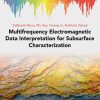Sediment Provenance. Influences on Compositional Change from Source to Sink 1st Edition Rajat Mazumder – eBook PDF
$50.00 Original price was: $50.00.$35.00Current price is: $35.00.
Sediment Provenance. Influences on Compositional Change from Source to Sink – Ebook PDF
Sediment Provenance. Influences on Compositional Change from Source to Sink – Ebook PDF Instant Delivery – ISBN(s): 9780128033869,9780128033876,012803386X,0128033878
Product details:
- ISBN: 9780128033869
- Author: Rajat Mazumder
Sediment Provenance: Influences on Compositional Change from Source to Sink provides a thorough and inclusive overview that features data-based case studies on a broad range of dynamic aspects in sedimentary rock structure and deposition. Provenance data plays a critical role in a number of aspects of sedimentary rocks, including the assessment of palaeogeographic reconstructions, the constraints of lateral displacements in orogens, the characterization of crust which is no longer exposed, the mapping of depositional systems, sub-surface correlation, and in predicting reservoir quality.
Table contents:
Chapter 1. Sediment Provenance: Influence on Compositional Change From Source to Sink
Chapter 2. Evolution of Siliciclastic Provenance Inquiries: A Critical Appraisal
Chapter 3. Tracing the Source of the Bio/Siliciclastic Beach Sands at Rosa Marina (Apulian Coast, SE Italy)Chapter 4. Changes in the Heavy-Mineral Spectra on Their Way From Various Sources to Joint Sinks: A Case Study of Pleistocene Sandurs and an Ice-Marginal Valley in Northwest Poland
Chapter 5. Reconstructions of Paleohydraulic Conditions From Primary Sedimentary Structures: Problems and Implications for Sediment Provenance
Chapter 6. Physico-Chemical Characteristics of the Barremian-Aptian Siliciclastic Rocks in the Pondicherry Embryonic Rift Sub-basin, India
Chapter 7. Petrological and Geochemical Constraints on Provenance, Paleoweathering, and Tectonic Setting of Clastic Sediments From the Neogene Lambir and Sibuti Formations, Northwest Borneo
Chapter 8. What Are the Origins of V-Shaped (Chevron) Dunes in Madagascar? The Case for Their Deposition by a Holocene Megatsunami
Chapter 9. The Contourite Problem
Chapter 10. Fluvial Systems, Provenance, and Reservoir Development in the Eocene Brennan Basin Member of the Duchesne River Formation, Northern Uinta Basin, Utah
Chapter 11. Changes in the Shape of Breccia Lenses Sliding From Source to Sink in the Cambrian Epeiric Sea of the North China Platform
Chapter 12. Provenance of Chert Rudites and Arenites in the Northern Canadian Cordillera
Chapter 13. Late Neoproterozoic to Early Mesozoic Sedimentary Rocks of the Tasmanides, Eastern Australia: Provenance Switching Associated With Development of the East Gondwana Active Margin
Chapter 14. Utility of Detrital Zircon Grains From Upper Amphibolite Facies Rocks of the Grenville Supergroup, Adirondack Lowlands, Northeastern United States
Chapter 15. Detrital Zircon U-Pb Geochronology, Nd Isotope Mapping, and Sediment Geochemistry From the Singhora Group, Central India: Implications Toward Provenance, Its Shift, and Regional Stratigraphic Correlation
Chapter 16. Deciphering Sedimentary Provenance and Timing of Sedimentation From a Suite of Metapelites From the Chotanagpur Granite Gneissic Complex, India: Implications for Proterozoic Tectonics in the East-Central Part of the Indian Shield
Chapter 17. SEM-CL Fabric Analysis of Quartz Framework Population From the Mesoarchean Keonjhar Quartzite From Singhbhum Craton, Eastern India: Implications for the Understanding of the Upper Continental Crust
Chapter 18. Provenance of Detrital Pyrite in Archean Sedimentary Rocks: Examples From the Witwatersrand Basin
Chapter 19. Ice Ages in Earth History: Puzzling Paleolatitudes and Regional Provenance of Ice Sheets on an Evolving Planet
Chapter 20. The Isua Supracrustal Belt of the North Atlantic Craton (Greenland): Spotlight on Sedimentary Systems With the Oldest Preserved Sedimentary Structures (∼3.7, ∼3.75, and ∼3.8Ga)
People also search:
what is the source of sediment
why do glaciers deposit sediment
a sediment particle transported by a stream
what factors contributed to south america becoming a hollow continent
what can change the speed of sound through a material


